A Particle Swarm Optimization-Based Queue Scheduling and Optimization Mechanism for Large-Scale Low-Earth-Orbit Satellite Communication Networks
Abstract
1. Introduction
- This paper proposes a novel scheduling and optimization mechanism specifically tailored for large-scale LEO satellite communication networks, capable of effectively managing time-sensitive service loads;
- This paper incorporates the PSO algorithm to optimize the lengths and numbers of the queues within the output ports of each satellite node, obtaining the optimal queue configurations for handling time-sensitive traffic;
- Through simulation validation, this paper demonstrates that this mechanism can provide the high-quality and efficient transmission of time-sensitive service traffic in large-scale LEO satellite communication networks.
2. Queue Scheduling and Optimization Mechanism of Large-Scale LEO Satellite Communication Networks
2.1. CQF Mechanism
2.2. On-Board Switch Architecture for LEO Satellites
2.3. Queue Analysis and Optimization Mechanism Based on PSO Algorithm
| Algorithm 1: PSO-QSO mechanism. |
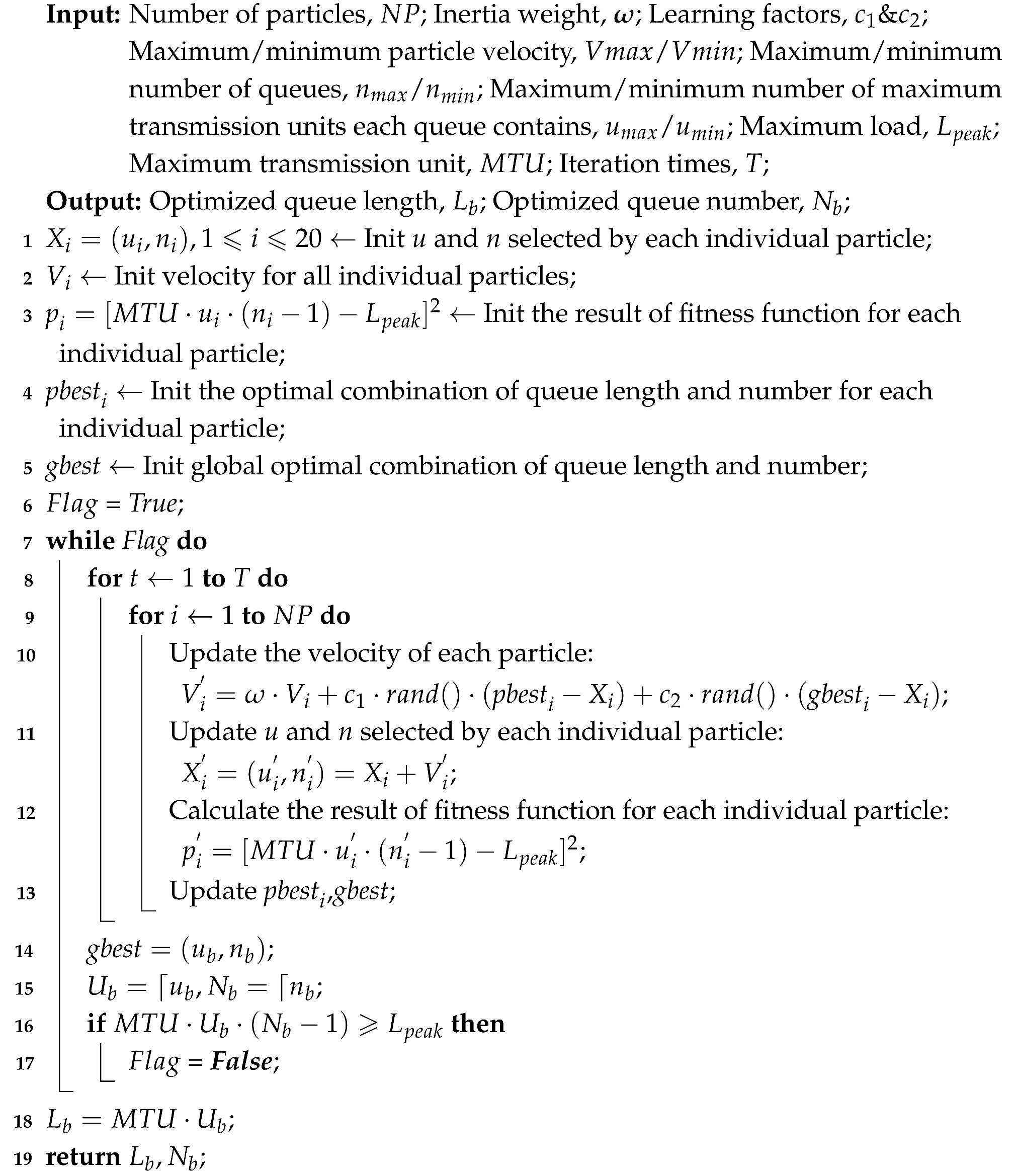 |
3. Results
- Cluster formation: one satellite in each of three adjacent orbital planes, numbered 17, 28, and 39. They can correspond to S3, S4, and S5 in Figure 4.
- Trailing formation: three adjacent satellites in the same orbital plane; their numbers are 27, 28, 29. Similarly, they can correspond to S3’, S4’, and S5’ in Figure 4.
3.1. Transmission Delay and Total Queuing Delay of Multi-Node End-to-End Transmission
3.2. Packet Loss Rate of Multi-Node End-to-End Transmission
3.3. Network Throughput Calculation
3.4. Comparison of Computational Complexity Between Optimization Algorithm and Traditional Algorithm
4. Discussion
5. Conclusions
Author Contributions
Funding
Institutional Review Board Statement
Informed Consent Statement
Data Availability Statement
Conflicts of Interest
References
- Su, Y.; Liu, Y.; Zhou, Y.; Yuan, J.; Cao, H.; Shi, J. Broadband LEO Satellite Communications: Architectures and Key Technologies. IEEE Wirel. Commun. 2019, 26, 55–61. [Google Scholar] [CrossRef]
- Wang, R.; Kishk, M.A.; Alouini, M.S. Ultra-Dense LEO Satellite-Based Communication Systems: A Novel Modeling Technique. IEEE Commun. Mag. 2022, 60, 25–31. [Google Scholar] [CrossRef]
- Qu, Z.; Zhang, G.; Cao, H.; Xie, J. LEO Satellite Constellation for Internet of Things. IEEE Access 2017, 5, 18391–18401. [Google Scholar] [CrossRef]
- Chai, F.; Zhang, Q.; Yao, H.; Xin, X.; Gao, R.; Guizani, M. Joint Multi-Task Offloading and Resource Allocation for Mobile Edge Computing Systems in Satellite IoT. IEEE Trans. Veh. Technol. 2023, 72, 7783–7795. [Google Scholar] [CrossRef]
- Di, B.; Song, L.; Li, Y.; Poor, H.V. Ultra-Dense LEO: Integration of Satellite Access Networks into 5G and Beyond. IEEE Wirel. Commun. 2019, 26, 62–69. [Google Scholar] [CrossRef]
- Yong, J.; Wen, F.; Hu, Z.; Fan, F.; Qiu, K. High-Dynamic Transmission Modeling for Laser Inter-Satellite Links (LISLs). In Proceedings of the 2022 Asia Communications and Photonics Conference (ACP), Shenzhen, China, 5–8 November 2022; pp. 590–594. [Google Scholar] [CrossRef]
- Lai, Z.; Liu, W.; Wu, Q.; Li, H.; Xu, J.; Wu, J. SpaceRTC: Unleashing the Low-latency Potential of Mega-constellations for Real-Time Communications. In Proceedings of the IEEE INFOCOM 2022—IEEE Conference on Computer Communications, London, UK, 2–5 May 2022; pp. 1339–1348. [Google Scholar] [CrossRef]
- Liu, S.; Gao, Z.; Wu, Y.; Kwan Ng, D.W.; Gao, X.; Wong, K.K.; Chatzinotas, S.; Ottersten, B. LEO Satellite Constellations for 5G and Beyond: How Will They Reshape Vertical Domains? IEEE Commun. Mag. 2021, 59, 30–36. [Google Scholar] [CrossRef]
- Nasrallah, A.; Balasubramanian, V.; Thyagaturu, A.; Reisslein, M.; Elbakoury, H. Cyclic Queuing and Forwarding for Large Scale Deterministic Networks: A Survey. arXiv 2019, arXiv:1905.08478. [Google Scholar]
- IEEE Standard Association. IEEE Standard for Local and Metropolitan Area Network-Bridges and Bridged Networks. IEEE Std. 2018, 802, 1–1993. [Google Scholar]
- Yan, J.; Quan, W.; Jiang, X.; Sun, Z. Injection Time Planning: Making CQF Practical in Time-Sensitive Networking. In Proceedings of the IEEE INFOCOM 2020—IEEE Conference on Computer Communications, Toronto, ON, Canada, 6–9 July 2020; pp. 616–625. [Google Scholar] [CrossRef]
- Wang, S.; Wu, B.; Zhang, C.; Huang, Y.; Huang, T.; Liu, Y. Large-Scale Deterministic IP Networks on CENI. In Proceedings of the IEEE INFOCOM 2021—IEEE Conference on Computer Communications Workshops (INFOCOM WKSHPS), Vancouver, BC, Canada, 10–13 May 2021; pp. 1–6. [Google Scholar] [CrossRef]
- Krolikowski, J.; Martin, S.; Medagliani, P.; Leguay, J.; Chen, S.; Chang, X.; Geng, X. Joint routing and scheduling for large-scale deterministic IP networks. Comput. Commun. 2021, 165, 33–42. [Google Scholar] [CrossRef]
- Badar, A.; Lou, D.Z.; Graf, U.; Barth, C.; Stich, C. Intelligent Edge Control with Deterministic-IP based Industrial Communication in Process Automation. In Proceedings of the 2019 15th International Conference on Network and Service Management (CNSM), Halifax, NS, Canada, 21–25 October 2019; pp. 1–7. [Google Scholar] [CrossRef]
- Quan, W.; Yan, J.; Jiang, X.; Sun, Z. On-line Traffic Scheduling optimization in IEEE 802.1Qch based Time-Sensitive Networks. In Proceedings of the 2020 IEEE 22nd International Conference on High Performance Computing and Communications; IEEE 18th International Conference on Smart City; IEEE 6th International Conference on Data Science and Systems (HPCC/SmartCity/DSS), Yanuca Island, Cuvu, Fiji, 14–16 December 2020; pp. 369–376. [Google Scholar] [CrossRef]
- IEEE 802.1Qch-2017; IEEE Standard for Local and metropolitan area networks–Bridges and Bridged Networks–Amendment 29: Cyclic Queuing and Forwarding. IEEE: New York, NY, USA, 2017; pp. 1–30. [CrossRef]
- Wang, F.; Wu, D.; He, W.; Li, Z.; Zhang, Q.; Yao, H. CPF: Bridging Time-Sensitive Networks into Large-Scale LEO Satellite Networks. In Proceedings of the 2023 International Wireless Communications and Mobile Computing (IWCMC), Marrakesh, Morocco, 19–23 June 2023; pp. 1–6. [Google Scholar] [CrossRef]
- Liu, C.; Liu, Y. A Real-Time Distributed Algorithm for Satellite Constellation Routing. In Proceedings of the 2018 IEEE 18th International Conference on Communication Technology (ICCT), Chongqing, China, 8–11 October 2018; pp. 745–749. [Google Scholar] [CrossRef]
- Gao, W.; Song, C.; Jiang, J.; Zhang, C. Simplified Particle Swarm Optimization Algorithm Based on Improved Learning Factors. In Advances in Neural Networks-ISNN 2017: 14th International Symposium, ISNN 2017, Sapporo, Hakodate, and Muroran, Hokkaido, Japan, 21–26 June 2017; Cong, F., Leung, A., Wei, Q., Eds.; Springer: Berlin/Heidelberg, Germany, 2017; pp. 321–328. [Google Scholar]
- Jiao, B.; Lian, Z.; Gu, X. A dynamic inertia weight particle swarm optimization algorithm. Chaos Solitons Fractals 2008, 37, 698–705. [Google Scholar] [CrossRef]
- Piotrowski, A.P.; Napiorkowski, J.J.; Piotrowska, A.E. Population size in Particle Swarm Optimization. Swarm Evol. Comput. 2020, 58, 100718. [Google Scholar] [CrossRef]
- Leopold, R.; Miller, A. The IRIDIUM communications system. In Proceedings of the 1993 IEEE MTT-S International Microwave Symposium Digest, Atlanta, GA, USA, 14–18 June 1993; Volume 2, pp. 575–578. [Google Scholar] [CrossRef]
- Kapoor, R.; Snoeren, A.; Voelker, G.; Porter, G. Bullet trains: A study of NIC burst behavior at microsecond timescales. In Proceedings of the Ninth ACM Conference on Emerging Networking Experiments and Technologies, Santa Barbara, CA, USA, 9–12 December 2013; pp. 133–138. [Google Scholar] [CrossRef]
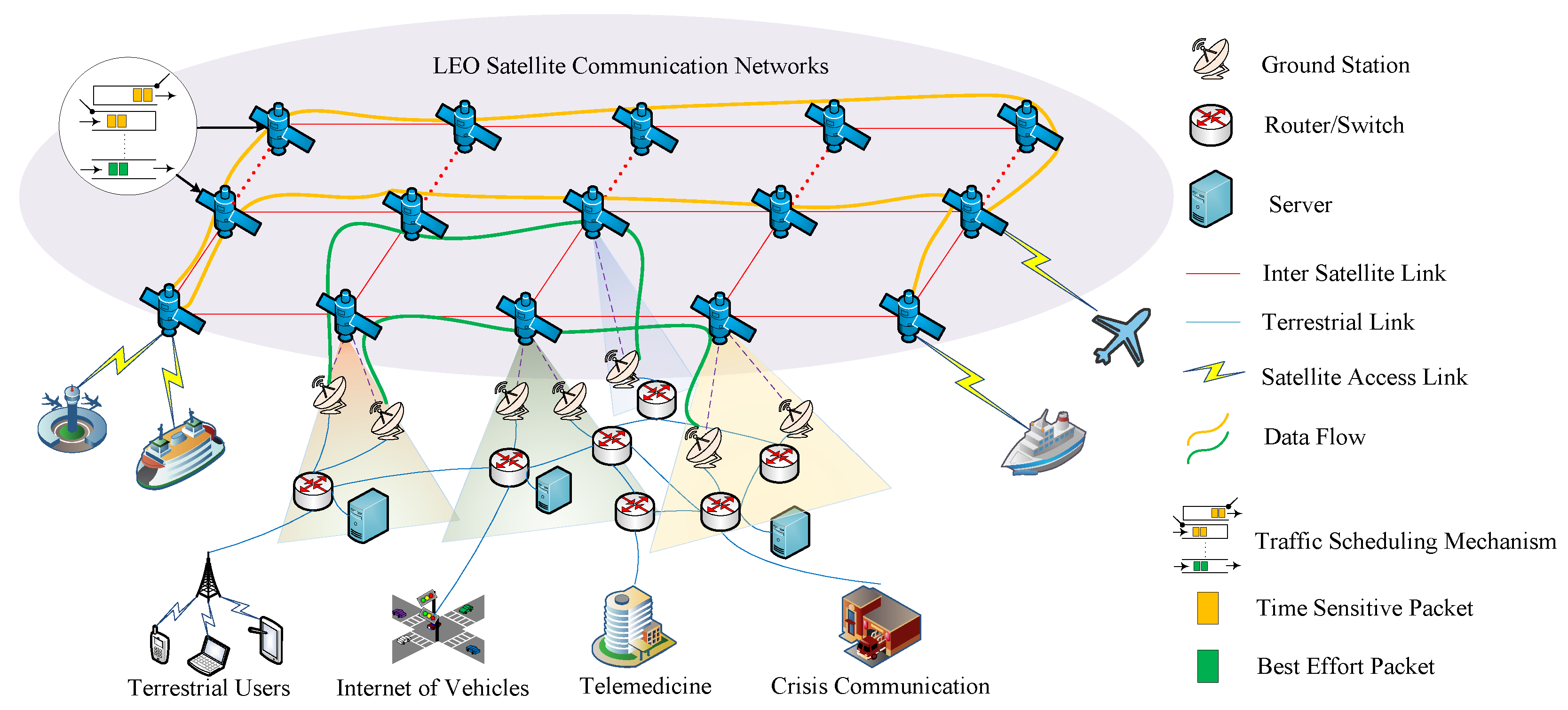
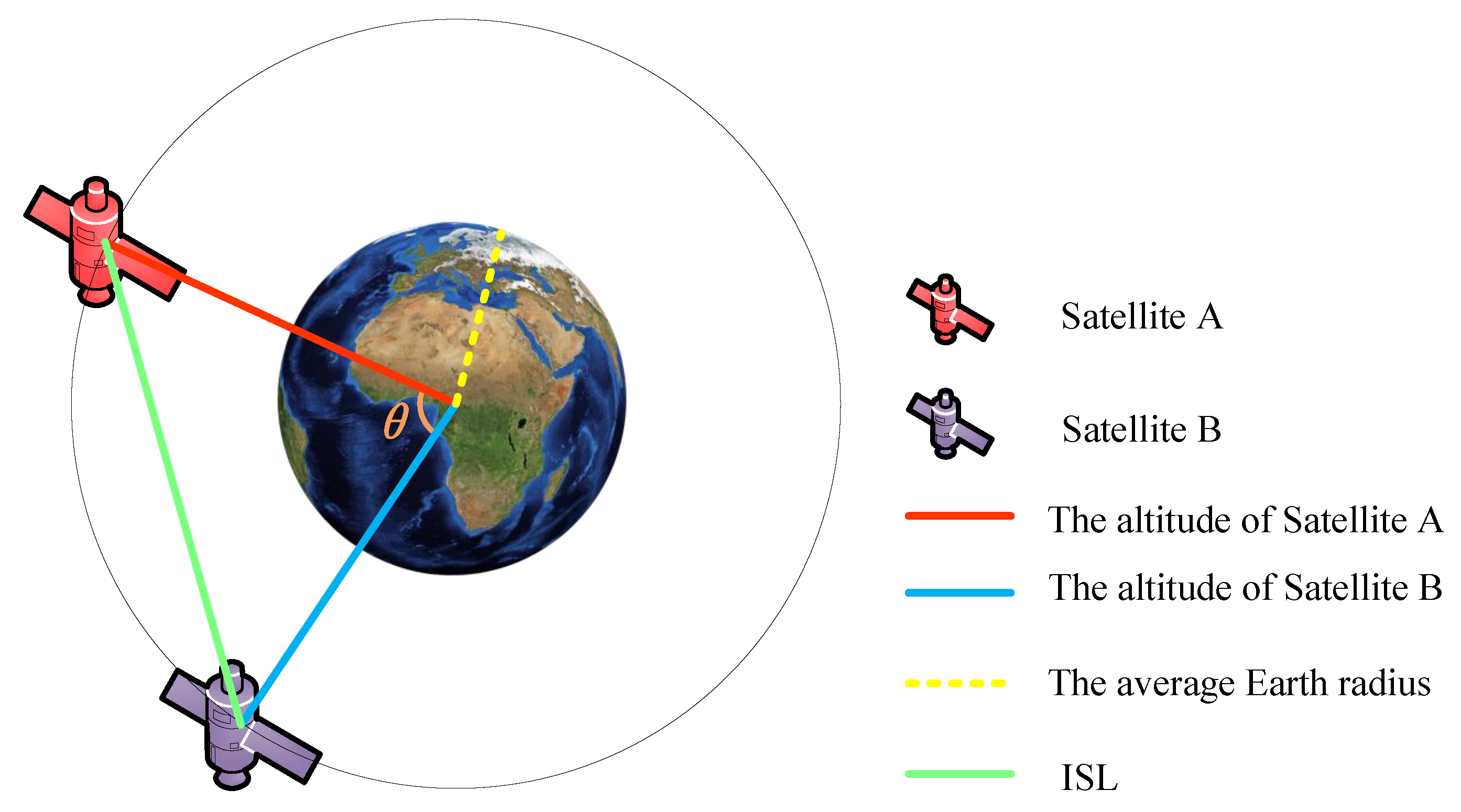
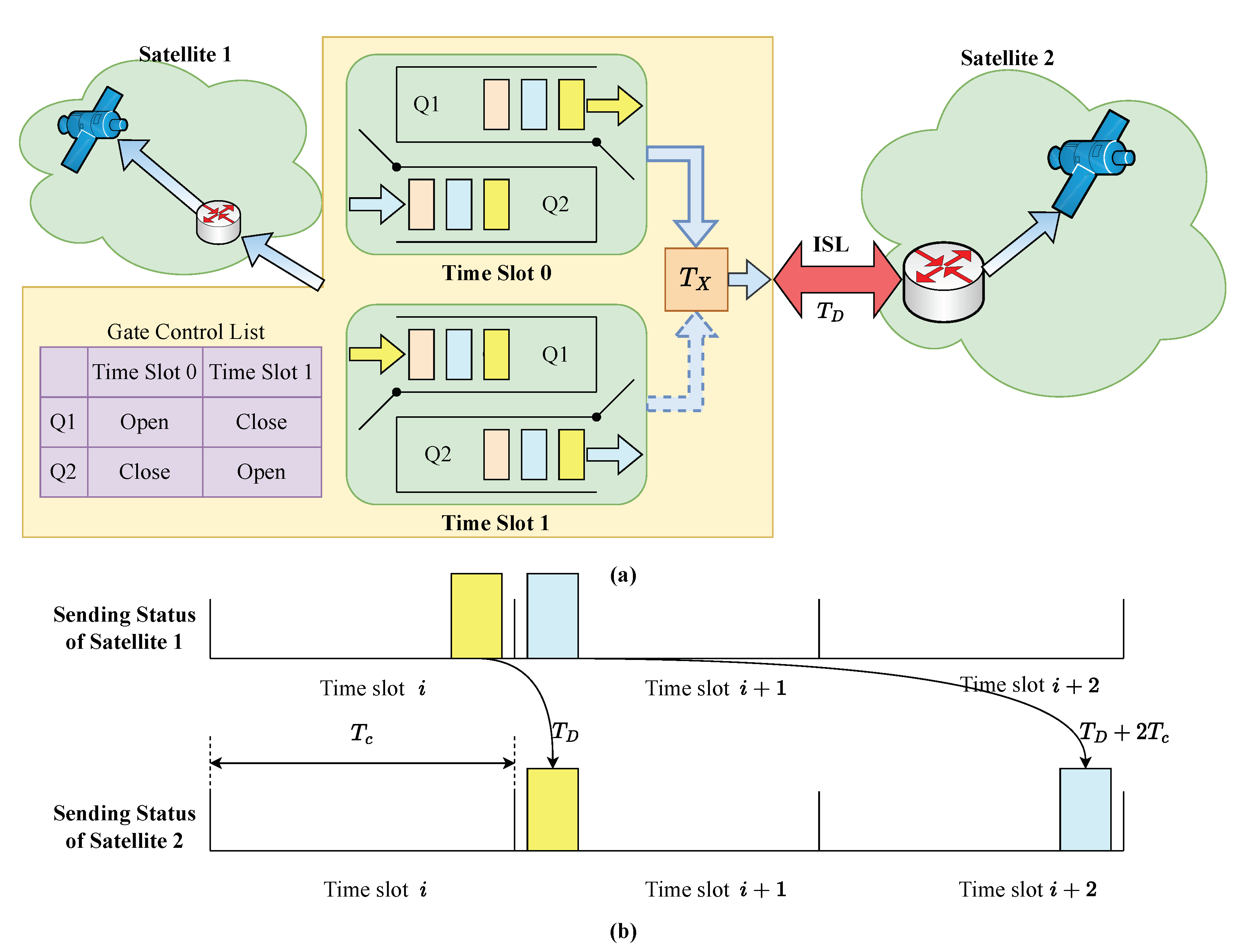
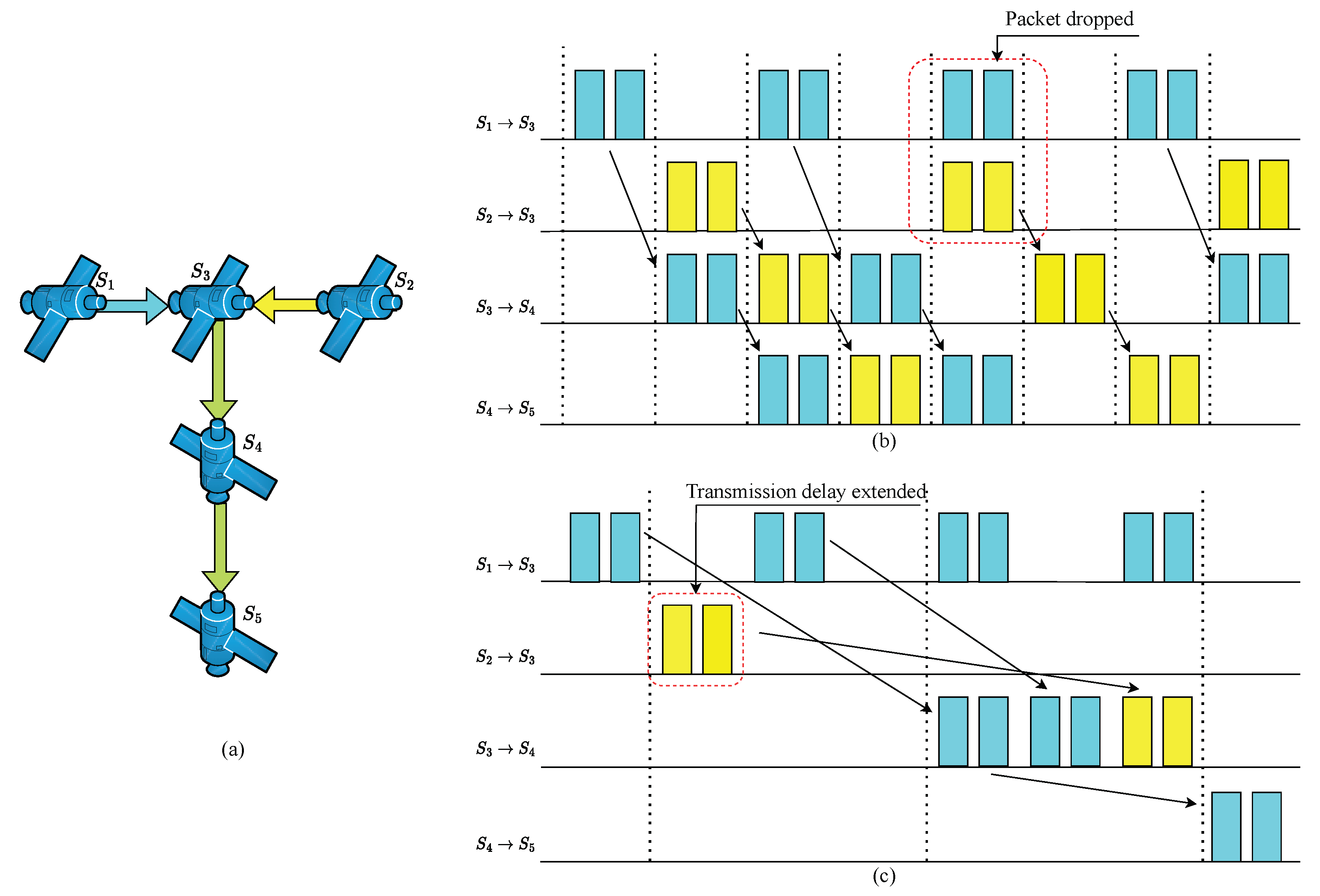


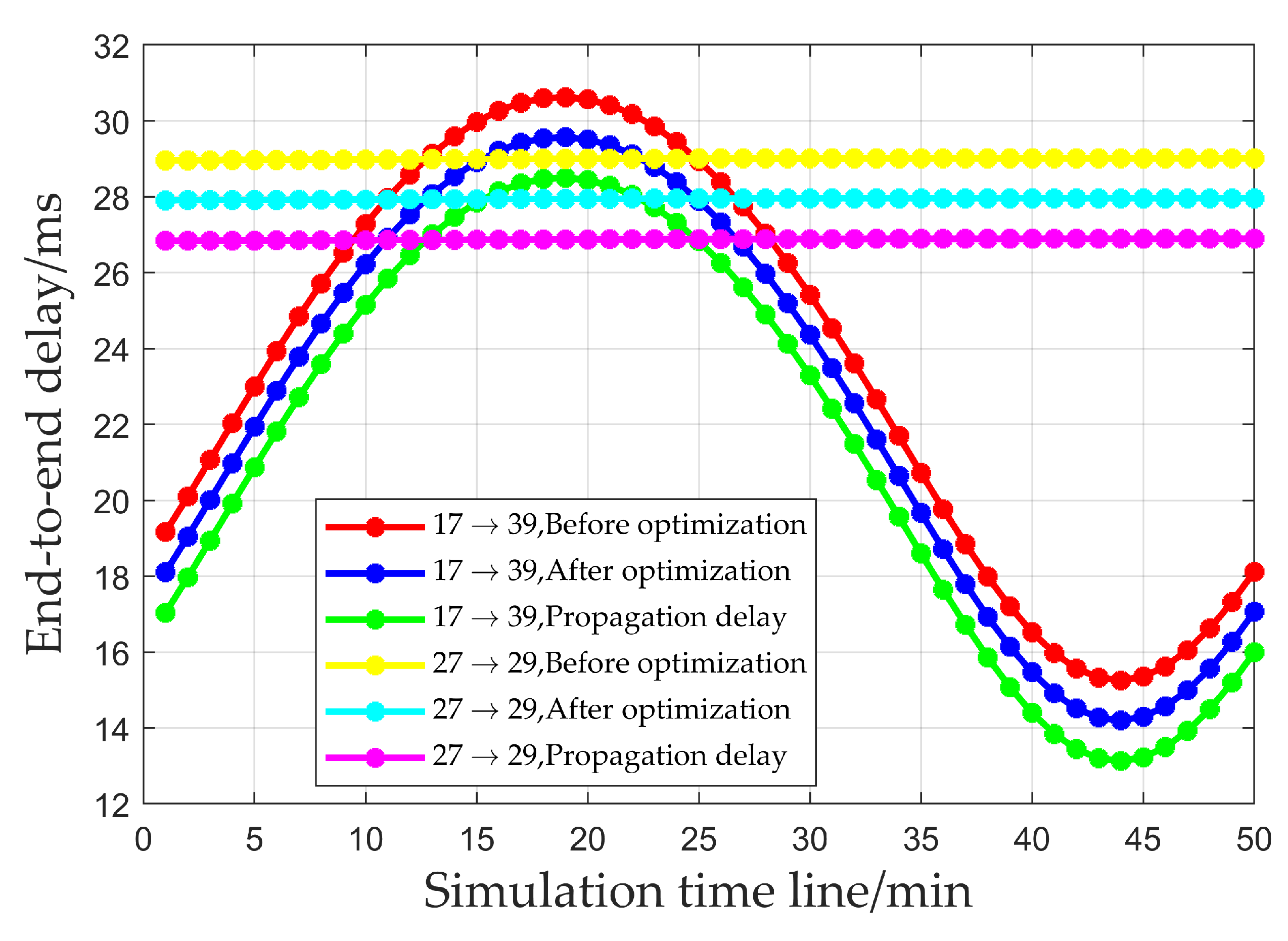


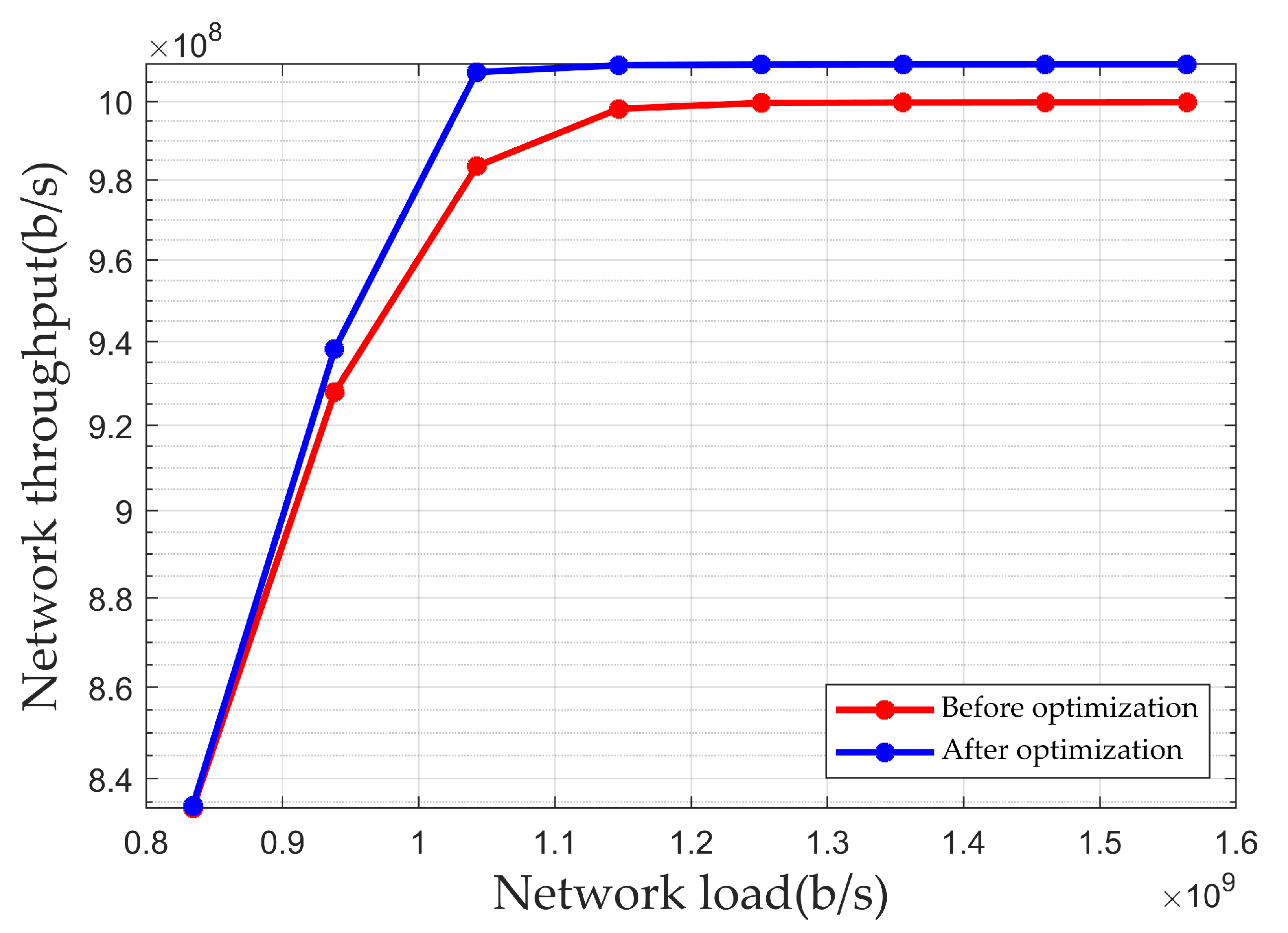

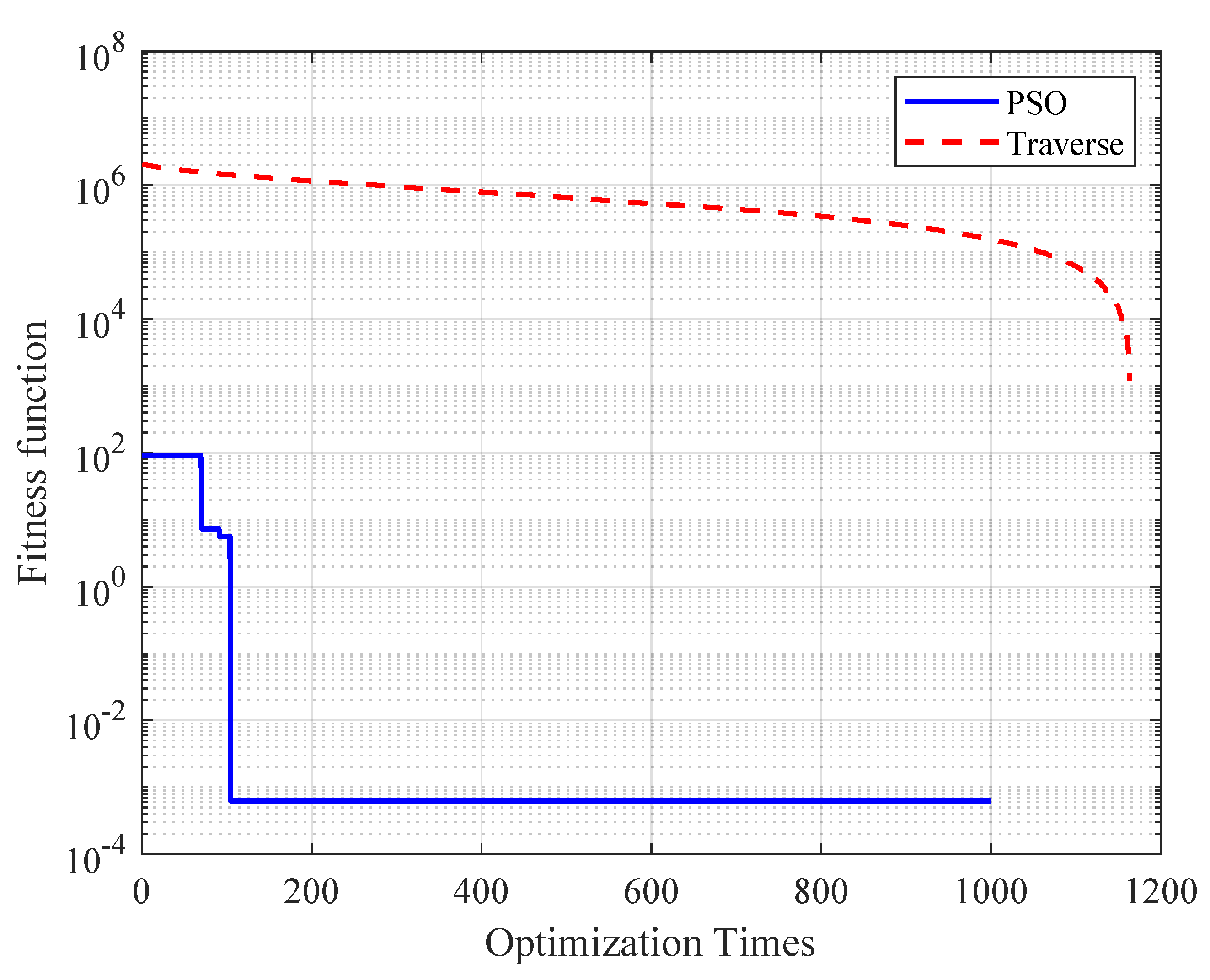
| Parameters | Value |
|---|---|
| Total number of satellites (N) | 66 |
| Satellites in each orbital plane () | 11 |
| Number of particles () | 20 |
| Maximum number of iterations (T) | 1000 |
| Learning factors (, ) | 1.5 |
| Inertia weight () | 0.9 |
| Maximum position of each particle () | (200, 7) |
| Minimum position of each particle () | (1, 2) |
| Maximum Transmission Unit (MTU) | 1500 bytes |
Disclaimer/Publisher’s Note: The statements, opinions and data contained in all publications are solely those of the individual author(s) and contributor(s) and not of MDPI and/or the editor(s). MDPI and/or the editor(s) disclaim responsibility for any injury to people or property resulting from any ideas, methods, instructions or products referred to in the content. |
© 2025 by the authors. Licensee MDPI, Basel, Switzerland. This article is an open access article distributed under the terms and conditions of the Creative Commons Attribution (CC BY) license (https://creativecommons.org/licenses/by/4.0/).
Share and Cite
Zhang, Z.; Dong, T.; Yin, J.; Xu, Y.; Luo, Z.; Jiang, H.; Wu, J. A Particle Swarm Optimization-Based Queue Scheduling and Optimization Mechanism for Large-Scale Low-Earth-Orbit Satellite Communication Networks. Sensors 2025, 25, 1069. https://doi.org/10.3390/s25041069
Zhang Z, Dong T, Yin J, Xu Y, Luo Z, Jiang H, Wu J. A Particle Swarm Optimization-Based Queue Scheduling and Optimization Mechanism for Large-Scale Low-Earth-Orbit Satellite Communication Networks. Sensors. 2025; 25(4):1069. https://doi.org/10.3390/s25041069
Chicago/Turabian StyleZhang, Ziyong, Tao Dong, Jie Yin, Yue Xu, Zongyi Luo, Hao Jiang, and Jing Wu. 2025. "A Particle Swarm Optimization-Based Queue Scheduling and Optimization Mechanism for Large-Scale Low-Earth-Orbit Satellite Communication Networks" Sensors 25, no. 4: 1069. https://doi.org/10.3390/s25041069
APA StyleZhang, Z., Dong, T., Yin, J., Xu, Y., Luo, Z., Jiang, H., & Wu, J. (2025). A Particle Swarm Optimization-Based Queue Scheduling and Optimization Mechanism for Large-Scale Low-Earth-Orbit Satellite Communication Networks. Sensors, 25(4), 1069. https://doi.org/10.3390/s25041069





